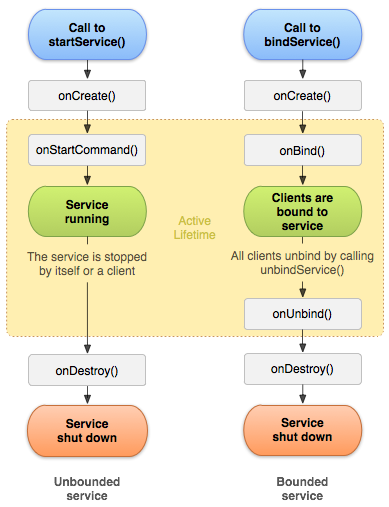标签:操作文件 音乐 播放 生命周期 text ima 交互 机制 params
Service(服务)是一个没有用户界面的在后台运行执行耗时操作的应用组件。其他应用组件能够启动Service,并且当用户切换到另外的应用场景,Service将持续在后台运行。另外,一个组件能够绑定到一个service与之交互(IPC机制),例如,一个service可能会处理网络操作,播放音乐,操作文件I/O或者与内容提供者(content
provider)交互,所有这些活动都是在后台进行。Service有两种状态,“启动的”和“绑定”
Service默认跑在主线程,所以是在Service里建立子线程而不是建立子线程跑Service。
定义一个服务:新建类继承Service类
onBind方法是必须覆盖的,而其他三个分别是创建时调用,销毁时调用,启动时调用
public class MyService extends Service {
@Override
public IBinder onBind(Intent intent) {
return null;
}
@Override
public void onCreate() {
super.onCreate();
}
@Override
public int onStartCommand(Intent intent, int flags, int startId) {
return super.onStartCommand(intent, flags, startId);
}
@Override
public void onDestroy() {
super.onDestroy();
}
}注册Service,同样是在配置文件中:
<service android:name=".MyService" />启动服务和停止服务:
switch (v.getId()) {
case R.id.button1:
Intent startIntent =new Intent(this,MyService.class);
startService(startIntent);
break;
case R.id.button2:
Intent stopIntent =new Intent(this,MyService.class);
stopService(stopIntent);
break;
}
Service自己结束自己:stopSelf();
如果要服务完成什么功能,写在onStartCommand方法里面即可。
使用Binder对象可以进行两者通信,方法如下:
1. 在service里面新建Binder类继承Binder:
class MyBinder extends Binder{
public void MyStart(){
Log.d("Service", "MyStart: MyStart");
}
}private MyBinder mybinder;
@Override
public IBinder onBind(Intent intent) {
return mybinder;
}private MyService.MyBinder myBinder;
private ServiceConnection connection=new ServiceConnection() {
@Override
public void onServiceConnected(ComponentName name, IBinder service) {
//绑定调用
}
@Override
public void onServiceDisconnected(ComponentName name) {
//j解绑调用
}
};绑定服务
case R.id.button3:
Intent bindIntent=new Intent(this,MyService.class);
bindService(bindIntent,connection,BIND_AUTO_CREATE);
break;
case R.id.button4:
unbindService(connection);
break;调用服务的方法:
写在onServiceConnected里面:
@Override
public void onServiceConnected(ComponentName name, IBinder service) {
myBinder=(MyService.MyBinder) service;
myBinder.MyStart();
}
通过这个图可以看到,两种启动service的方式以及他们的生命周期,bind service的不同之处在于当绑定的组件销毁后,对应的service也就被kill了。service的声明周期相比与activity的简单了许多,只要好好理解两种启动service方式的异同就行。
??Service(服务)是一个一种可以在后台执行长时间运行操作而没有用户界面的组件。它运行于UI线程,因此不能进行耗时的操作。
??Service的运行是在UI线程当中的,是绝对绝对不能进行耗时操作的,而Thread开启的子线程则可以进行耗时操作,但是Thread开启的子线程是不能直接对UI进行操作的,否则极有可能发生直接让程序崩掉,这就是它们的区别。
??步骤:
??a.定义一个类继承Service。
??b.在AndroidManifest.xml文件中配置该Service。
??c.使用Context的startService(Intent)方法启动该Service。
??d.不再使用该Service时,调用Context的stopService(Intent)方法停止该Service。
??步骤:
??a.创建BinderService服务端,继承自Service并在类中创建一个实现IBinder接口的实现实例对象并提供公共方法给客户端调用。
??b.从onBind()回调方法返回此Binder实例。
??c.在客户端中,从onServiceConnected回调方法接收Binder,并使用提供的方法调用绑定服务。
??服务的生命周期有两种,因为服务可以跟Activity绑定起来,也可以不绑定,Activity和服务进行通信的话,是需要把服务和Activity进行绑定的。因此服务的生命周期分为未绑定Activity的和绑定Activity的。
没有绑定Activity的服务生命周期图:
绑定Activity的服务生命周期图:
1.通过Intent和startService()方法启动了一个服务,接下来执行onCreate()方法,首次创建服务时,系统将调用此方法来执行一次性设置程序(在调用 onStartCommand() 或 onBind() 之前)。如果服务已在运行,则不会调用此方法。
2.当另一个组件(如 Activity)通过调用 startService() 请求启动服务时,系统将调用此方法。一旦执行此方法,服务即会启动并可在后台无限期运行。 如果您实现此方法,则在服务工作完成后,需要由您通过调用 stopSelf() 或 stopService() 来停止服务。(如果您只想提供绑定,则无需实现此方法。)
3.服务开始处于运行状态。
4.某个操作导致服务停止,比如执行了方法stopService(),那么服务接下来会执行onDestory()销毁。服务应该实现此方法来清理所有资源,如线程、注册的侦听器、接收器等。 这是服务接收的最后一个调用。
5.服务被完全销毁,下一步就是等待被垃圾回收器回收了。
6.通过Intent和bindService()方法启动了一个服务,接下来会执行onCreate()方法,首次创建服务时,系统将调用此方法来执行一次性设置程序(在调用 onStartCommand() 或 onBind() 之前)。如果服务已在运行,则不会调用此方法。
7.当另一个组件想通过调用 bindService() 与服务绑定(例如执行 RPC)时,系统将调用此方法。在此方法的实现中,您必须通过返回 IBinder 提供一个接口,供客户端用来与服务进行通信。请务必实现此方法,但如果您并不希望允许绑定,则应返回 null。
8.服务开始处于运行状态。成功与Activity绑定。
9.某个操作导致服务解除绑定,比如执行了方法unbindService(),那么服务接下来会解除与当前Activity的绑定。接下来服务将面临销毁。
10.服务执行onDestory()方法被销毁。服务应该实现此方法来清理所有资源,如线程、注册的侦听器、接收器等。 这是服务接收的最后一个调用。
11.服务被完全销毁,下一步就是等待被垃圾回收器回收了。
关于服务,总结一下:
a. 被启动的服务的生命周期:如果一个Service被某个Activity 调用 Context.startService 方法启动,那么不管是否有Activity使用bindService绑定或unbindService解除绑定到该Service,该Service都在后台运行。如果一个Service被startService 方法多次启动,那么onCreate方法只会调用一次,onStart将会被调用多次(对应调用startService的次数),并且系统只会创建Service的一个实例(因此你应该知道只需要一次stopService调用)。该Service将会一直在后台运行,而不管对应程序的Activity是否在运行,直到被调用stopService,或自身的stopSelf方法。当然如果系统资源不足,android系统也可能结束服务。
b. 被绑定的服务的生命周期:如果一个Service被某个Activity 调用 Context.bindService 方法绑定启动,不管调用 bindService 调用几次,onCreate方法都只会调用一次,同时onStart方法始终不会被调用。当连接建立之后,Service将会一直运行,除非调用Context.unbindService 断开连接或者之前调用bindService 的 Context 不存在了(如Activity被finish的时候),系统将会自动停止Service,对应onDestroy将被调用。
c. 被启动又被绑定的服务的生命周期:如果一个Service又被启动又被绑定,则该Service将会一直在后台运行。并且不管如何调用,onCreate始终只会调用一次,对应startService调用多少次,Service的onStart便会调用多少次。调用unbindService将不会停止Service,而必须调用 stopService 或 Service的 stopSelf 来停止服务。
d. 当服务被停止时清除服务:当一个Service被终止(1、调用stopService;2、调用stopSelf;3、不再有绑定的连接(没有被启动))时,onDestroy方法将会被调用,在这里你应当做一些清除工作,如停止在Service中创建并运行的线程。
特别注意:
1、你应当知道在调用 bindService 绑定到Service的时候,你就应当保证在某处调用 unbindService 解除绑定(尽管 Activity 被 finish 的时候绑定会自动解除,并且Service会自动停止);
2、你应当注意 使用 startService 启动服务之后,一定要使用 stopService停止服务,不管你是否使用bindService;
3、同时使用 startService 与 bindService 要注意到,Service 的终止,需要unbindService与stopService同时调用,才能终止 Service,不管 startService 与 bindService 的调用顺序,如果先调用 unbindService 此时服务不会自动终止,再调用 stopService 之后服务才会停止,如果先调用 stopService 此时服务也不会终止,而再调用 unbindService 或者 之前调用 bindService 的 Context 不存在了(如Activity 被 finish 的时候)之后服务才会自动停止;
4、当在旋转手机屏幕的时候,当手机屏幕在“横”“竖”变换时,此时如果你的 Activity 如果会自动旋转的话,旋转其实是 Activity 的重新创建,因此旋转之前的使用 bindService 建立的连接便会断开(Context 不存在了),对应服务的生命周期与上述相同。
5、在 sdk 2.0 及其以后的版本中,对应的 onStart 已经被否决变为了 onStartCommand,不过之前的 onStart 任然有效。这意味着,如果你开发的应用程序用的 sdk 为 2.0 及其以后的版本,那么你应当使用 onStartCommand 而不是 onStart。
Service 与 Thread 无任何关系Service的后台概念后台:后台任务运行完全不依赖
UI,即使Activity被销毁 / 程序被关闭,只要进程还在,后台任务就可继续运行

Service 和 Thread联合着用,即在Service中再创建一个子线程(工作线程)去处理耗时操作逻辑,如下代码:@Override
public int onStartCommand(Intent intent, int flags, int startId) {
//新建工作线程
new Thread(new Runnable() {
@Override
public void run() {
// 开始执行后台任务
}
}).start();
return super.onStartCommand(intent, flags, startId);
}
class MyBinder extends Binder {
public void service_connect_Activity() {
//新建工作线程
new Thread(new Runnable() {
@Override
public void run() {
// 执行具体的下载任务
}
}).start();
}
} 标签:操作文件 音乐 播放 生命周期 text ima 交互 机制 params
原文地址:https://www.cnblogs.com/JLZT1223/p/9092609.html